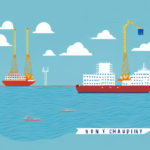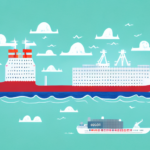Introduction to Scaled Shipping Operations
The shipping industry has seen remarkable growth, with global maritime trade volumes projected to reach 12.98 billion metric tons by 2025, according to the MarketsandMarkets report. Scaled shipping operations involve managing the transportation of goods on a large scale, utilizing various vessels to transport goods across different regions while ensuring timely and optimal delivery.
One of the primary challenges in scaled shipping operations is coordinating multiple vessels and routes. This requires meticulous planning and coordination to ensure efficient and cost-effective transportation. Additionally, navigating complex international regulations and customs procedures adds further complexity. Despite these challenges, scaled shipping operations are vital for businesses that need to transport large volumes of goods over long distances, offering significant cost savings and operational efficiencies when managed effectively.
Understanding Risk Management in Shipping
What is Risk Management?
Risk management in the shipping industry involves identifying, evaluating, and mitigating risks that may impact shipping operations. It encompasses understanding the risks associated with various activities and developing strategies to minimize their impact.
Effective risk management helps organizations avoid financial losses, reputational damage, and legal liabilities. It is a critical component of successful business strategies, enabling proactive identification and resolution of potential risks. Continuous monitoring and reassessment ensure that risk management strategies remain effective amidst changing circumstances.
Importance of Risk Management in the Shipping Industry
Risk management is essential for shipping companies due to the inherent risks in shipping operations, such as cargo loss, vessel damage, and personnel safety threats. Effective risk management strategies minimize the impact of these risks, ensuring smooth business operations.
Technological advancements play a crucial role in risk management within the shipping industry. Technologies like GPS tracking, weather monitoring systems, and automated cargo handling equipment help shipping companies identify potential risks and implement proactive measures to mitigate them. For example, GPS tracking assists in monitoring vessel movements to avoid piracy-prone areas, while weather monitoring systems provide early warnings of severe weather conditions that could disrupt operations.
According to the International Maritime Organization (IMO), integrating technology into risk management practices enhances the safety of personnel and cargo, reduces operational disruptions, and improves overall efficiency.
Types of Risks in Scaled Shipping Operations
Shipping operations face various types of risks, each with potential significant impacts:
- Cargo Damage: Damage can occur during transit, loading, or unloading operations, affecting the integrity and value of goods.
- Environmental Risks: Natural disasters, such as hurricanes and earthquakes, and incidents like oil spills pose threats to shipping operations and marine environments.
- Piracy: Piracy remains a significant concern, especially in regions like the Gulf of Aden and the Strait of Malacca.
- Economic Risks: Fluctuations in fuel prices, exchange rates, and operational costs can adversely affect a company's profitability.
- Regulatory Compliance: Adhering to international and national regulations, including safety standards, environmental laws, and customs regulations, is mandatory to avoid fines and legal repercussions.
- Geopolitical Risks: Political instability, conflicts, and sanctions can disrupt shipping routes and compromise the safety of crew and cargo.
For instance, the United Nations report highlights how geopolitical tensions can lead to the closure of key ports, affecting global supply chains significantly.
The Risk Management Process
The risk management process in shipping involves several critical steps:
- Risk Assessment: Identifying potential risks associated with shipping operations.
- Risk Evaluation: Assessing the likelihood and severity of each identified risk.
- Risk Mitigation: Developing and implementing strategies to address and minimize the impact of risks.
- Risk Monitoring: Continuously monitoring and reassessing risks and the effectiveness of mitigation strategies.
This iterative process ensures that shipping companies can adapt to new threats and maintain robust risk management strategies. According to a study by the World Maritime News, cyclical risk evaluation helps companies stay ahead of emerging risks, thereby safeguarding their operations and assets.
Developing and Implementing Risk Management Plans
Developing a Risk Management Plan
Creating a comprehensive risk management plan involves:
- Conducting a Thorough Risk Assessment: Identifying all potential risks and evaluating their likelihood and impact.
- Identifying Gaps: Assessing the effectiveness of current risk management strategies to identify areas needing improvement.
- Strategizing: Formulating strategies to mitigate identified risks, such as adopting new safety protocols or investing in advanced technology.
- Assigning Responsibilities: Designating team members responsible for implementing each aspect of the risk management plan.
- Setting Timelines: Establishing clear timelines for the implementation of risk mitigation strategies.
A well-developed plan ensures that all potential risks are adequately addressed and that the organization is prepared to handle any adverse events effectively.
Implementing the Risk Management Plan
Effective implementation of the risk management plan includes:
- Training Personnel: Educating staff on new safety protocols and risk management practices.
- Investing in Technology: Acquiring and deploying technologies that enhance risk detection and mitigation.
- Allocating Resources: Ensuring that sufficient resources are allocated to implement risk management strategies.
Regular reviews and updates to the risk management plan are essential to maintain its relevance and effectiveness. According to the Journal of Risk Research, ongoing training and resource allocation are critical factors in the successful implementation of risk management practices.
Monitoring and Reviewing Effectiveness
Continuous monitoring and evaluation of risk management strategies are vital to ensure their effectiveness. This involves:
- Measuring Impact: Assessing whether the implemented strategies effectively reduce the identified risks.
- Adjusting Strategies: Making necessary adjustments to strategies that are not performing as intended.
- Stakeholder Communication: Keeping all relevant stakeholders informed about the effectiveness and any changes in the risk management strategies.
Regular drills and simulated emergency responses can help ensure that personnel are prepared to act swiftly in the event of a crisis. The European Maritime Safety Agency (EMSA) emphasizes the importance of regular training and reviews to maintain effective risk management practices.
Challenges and Case Studies
Common Challenges in Implementing Risk Management Strategies
Implementing effective risk management strategies in shipping operations presents several challenges, including:
- Resistance to Change: Employees and management may resist changes to established protocols and practices.
- Lack of Resources: Limited financial and human resources can hinder the implementation of comprehensive risk management strategies.
- Inadequate Risk Management Culture: Without a strong culture that prioritizes risk management, strategies may not be effectively adopted or sustained.
Addressing these challenges requires strong leadership, adequate resource allocation, and fostering a culture of safety and risk awareness throughout the organization.
Case Studies of Successful Risk Management Strategies
Several shipping companies have demonstrated effective risk management practices:
- Maersk: Maersk has implemented robust risk management strategies to address piracy risks, including crew training on recognizing and avoiding pirate attacks, deploying armed guards on vessels, and using secure routing and surveillance systems.
- Evergreen Marine: Evergreen Marine utilizes advanced weather forecasting and route optimization technologies to mitigate environmental risks, ensuring timely and safe delivery of cargo.
- CMA CGM: CMA CGM employs comprehensive safety management systems and continuous training programs to enhance crew safety and mitigate operational risks.
These case studies highlight how proactive risk management can lead to enhanced safety, operational efficiency, and business continuity in the shipping industry.
Conclusion and Future Outlook
The shipping industry continues to face inherent risks that can have substantial consequences for businesses. However, with effective risk management strategies, these risks can be significantly mitigated. As the industry evolves, risk management practices must also adapt to address emerging challenges, such as climate change impacts, cyber threats, and shifting geopolitical landscapes.
Investing in advanced technologies, fostering a strong risk management culture, and continuously improving risk management frameworks are essential for companies to maintain a competitive edge and ensure sustainable operations. As global trade continues to grow, the importance of robust risk management in scaled shipping operations will only become more critical.
Effective risk management is not just a defensive measure but a strategic advantage that enables shipping companies to navigate complex challenges and capitalize on opportunities in the dynamic maritime industry.




















